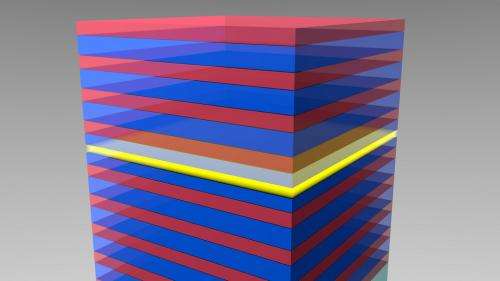Scientists demonstrate quantum phenomenon for the first time using a plastic film

For the first time, scientists at IBM Research have demonstrated a complex quantum mechanical phenomenon known as Bose-Einstein condensation (BEC), using a luminescent polymer (plastic) similar to the materials in light emitting displays used in many of today's smartphones.
This discovery has potential applications in developing novel optoelectronic devices including energy-efficient lasers and ultra-fast optical switches—critical components for powering future computer systems to process massive Big Data workloads. The use of a polymer material and the observation of BEC at room temperature provides substantial advantages in terms of applicability and cost.
IBM scientists around the world are focused on an ambitious data centric exascale computing program, which is aimed at developing systems that can process massive data workloads fifty times faster than today. Such a system will need optical interconnects capable of high-speed processing of Petabytes to Exabytes of Big Data. This will enable high-performance analytics for: energy grids, life sciences, financial modelling, business intelligence and weather and climate forecasting.
The complex phenomenon IBM scientists demonstrated at room temperature is named after the renown scientists Satyendranath Bose and Albert Einstein who first predicted it in the mid-1920s and only later experimentally proven in 1995.
A Bose-Einstein Condensate is a peculiar state of matter which occurs when a dilute gas of particles (bosons) are cooled to nearly absolute zero (-273 Celsius, -459 Fahrenheit). At this temperature intriguing macroscopic quantum phenomena occur in which the bosons all line up like ballroom dancers.
In 1995 this was demonstrated for the first time at these extreme temperatures, but today in a paper appearing in Nature Materials, IBM scientists have achieved the same state at room temperature using a thin non-crystalline polymer film developed by chemists at the University of Wuppertal in Germany.
In the experiment, a thin polymeric layer is placed between two mirrors and excited with laser light. This thin plastic film is approximately 35 nanometers thick, for comparison a sheet of paper is about 100,000 nanometers thick. The bosonic particles are created through interaction of the polymer material and light which bounces back and forth between the two mirrors.
The phenomenon only lasts for a few picoseconds (one trillionth of a second), but the scientists believe this is already long enough to use the bosons to create a source of laser-like light and/or an optical switch for future optical interconnects. These components are important building blocks to control the flow of information in the form of zeroes and ones between future chips and can significantly speed up their performance while using much less energy.
"That BEC would be possible using a polymer film instead of the usual ultra-pure crystals defied our expectations," said Dr. Thilo Stoferle, a physicist, at IBM Research. "It's really a beautiful example of quantum mechanics where one can directly see the quantum world on a macroscopic scale."
The next step for scientists is to study and control the extraordinary properties of the Bose-Einstein Condensate and to evaluate possible applications including analog quantum simulations. Such simulations could be used to model very complex scientific phenomena such as superconductivity, which is difficult using today's computational approaches.
More information: "Room-temperature Bose–Einstein condensation of cavity exciton–polaritons in a polymer." Johannes D. Plumhof, Thilo Stöferle, Lijian Mai, Ullrich Scherf, Rainer F. Mahrt. Nature Materials (2013) DOI: 10.1038/nmat3825 . Received 16 July 2013 Accepted 29 October 2013 Published online 08 December 2013
Journal information: Nature Materials
Provided by IBM



















